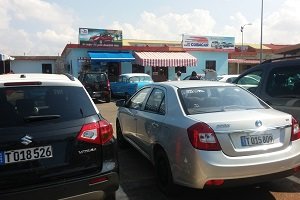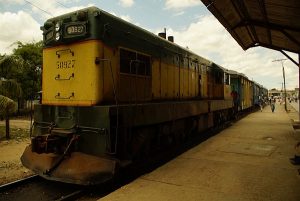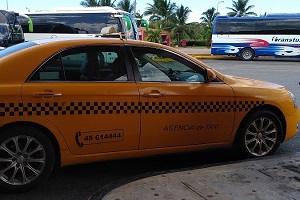Shared Taxis in Cuba

Updated: Dec 19, 2022
Home » Getting around Cuba: Options for Every BudgetShared taxis: a common mean of transport in Cuba

Updated: Dec 19, 2022
A common kind of transportation in Cuba are shared taxis. All over the island exist an extensive network of connections. Especially if you are traveling on a tight budget, a ride in a shared taxi could be your choice. Depending on the distance the prices vary around 2 to 5 USD per 100 km per passenger. Since time is money, rides are often quite adventurous, due to the bad condition of many vehicles. Therefore, share taxis are mainly a suitable mean of transport for brave backpackers.
Shared taxis are mostly the US classic cars for that Cuba is known. They are popularly known as maquina (machine) or almendron (because of their shape as a large almond) but foreigners also call them colectivos.
Maquinas not operate between larger cities only, they also connect most of the smaller towns. Besides those cars there are also busses, that operate in the same way, but serve longer distances. Most of these busses are converted old-timer trucks, that are known as camiones. In distinction to the state-run Viazul-Busses both, maquinas and camiones, are typically private-owned.
While a Viazul-Bus can't be stopped along the way, riding these vehicles you have the possibility to get out along the route or also in - if there is a free space. Like regular busses maquinas and camiones operate between bus stations on most connections, but sometimes there are also at different stops. This is the case in Havana, where exist several stops. In the Cuban capital this may be due to the size of the city, but also in other towns you have to expect different stops for different connections
­
The regular shared taxis is Cuba: Maquinas
The private-run maquinas operate on state-determined routes at fixed fares. From all Cuban cities it is generally possible to reach the next larger town, but not all routes are served.
If you want to take a ride to a city that you can't reach directly, you have to change the vehicle. As a general rule, you follow the direction of your final destination: If you plan to travel from Havana to Varadero, you usually have to go to Matanzas first. From Matanzas one can take a second ride to Varadero. Another example: In case you are traveling from Havana to Viñales, the first destination would be Pinar del Rio, from where a second ride would bring you to Viñales.
In most cities, the different lines operate at the same station, but unfortunately this is not always the case. As example, the mentioned journey from Havana to Pinar del Rio ends at the central bus station in Pinar del Rio. On the other hand, the shared taxis from Pinar del Rio to Viñales leave a bit outside the center (details below), what makes the whole trip a bit complicated.
Furthermore, you should know, that shared taxis have no timetables. Drivers typically wait at the bus stations - or the official stops - and leave as soon as they are fully occupied. Whereby "fully" means in most cases two passengers in the front (plus driver) and three in the back seat. Luckily, the vehicles are not overcrowded, but drive as they were once designed.
In bigger cars - like Jeeps - sometimes even fit six to nine people. Vehicles of this kind are often very uncomfortable. Sometimes you feel like in a can, because it is not possible to look outside, due to a lack of widows and space in the cabin. If you want to avoid such an uncomfortable ride, it is advisable to check the vehicle before departure.
Luckily regular cars are less uncomfortable, but there you should try to avoid the front center seat, if possible. This seat has not less space, it also gets particularly hot there, because you sit over the transmission. In order to be more comfortable, you can ask the driver to pay an extra seat and leave it empty. For example, two travelers who pay three seats in the back can often sit quite comfortable. Alternatively, a single traveler can pay the two seats in the front.
Between larger cities, you will generally find enough cars during the day. However, it is highly advisable to start your journey early, especially if your way is not on a main route. In general, you should try to be at the stop as early as possible, because also Cuban travelers do it so.
At the stops, you will often already find drivers waiting for passengers. If there is no driver on site, the passengers have to wait instead until all seats are occupied.
The drivers usually call out their routes from time to time. If you dare to share a ride, you should make sure to speak directly to the right driver. Where tourists pass, there are often smugglers, that try to get a commission by intermediate between the passenger and driver. In rarer cases, they also try to arrange private rides for visitors. Therefore, it's advisable to always first get an overview of the situation regarding the available drivers.
If you're lucky, the vehicle is in relatively good condition. If unlucky, you could end in an absolute junk car. A bad car is especially then an issue, if the driver is speeding. Another potential drawback is, that the interior of the vehicle can be polluted with engine exhaust fumes. You see, that in general a ride in one of these means of transport is nothing for sensitive travelers.
On the other hand, rides in shared cabs are very authentic and also quite cheap. That the prices are regulated by the state obviously doesn't mean, that some drivers demand higher prices from foreigners. Therefore, it is helpful to have an idea about the prices before starting a journey. One way to get an idea about the prices is to ask other passengers. Or just take a look at the following overview, that displays routes and prices for the most common routes.

Drivers in Cárdenas (2020)
­
Routes & Prices
From/to Havana.
From/to Varadero
From/to Trinidad
From/to Pinar del Rio
From/to Viñales
­
Private Trucks: sector privado
Most trucks for the transportation of passengers, the so-called camiones, are converted old trucks. Inside the vehicles, you often find newer seats from decommissioned coaches. According to Cuban standards, many vehicles are quite comfortable. In a lucky case, the car even has air conditioning. Sometimes you find screens to play - of course Cuban - music. To ensure that the truck is not too bad, you better take a look inside the cabin, before going on a longer trip. If the truck seems ok, then it is advisable to reserve a good seat.
A disadvantage is that most trucks stop very frequently. Especially during the day, people go off an on a long of the way. A common way of traveling in Cuba is to go to the highway and stop a truck - or anything that moves. Due to this culture, a longer journey can easily take twice the time a Viazul-Bus would take.
The sometimes martial looking vehicles serve fixed routes. Usually, trucks connect bus stations in different cities. Regular stops are mostly the larger cities along the main route. In order to avoid problems, it's recommended to ask the driver in advance if your desired destination will be reached.
In case your desired destination is not approached, you still have the option to get off as close as possible. To indicate a stop request, there is often a bell inside the cabin. In case there is no bell, you have to go the in the traditional way. Just scream and knock the driver's cabin with the hand. The real backpacker can so go off and make the last few kilometers on his own, like many Cubans do.

Inside a truck (2019)
There are different departure points in Havana. In other cities, the camiones usually start from the bus stations. If you want to dare to go on an adventure, you should take enough food and especially drinking water. The trucks stop from time to time. Breaks are made on request along the road and on rest places for Cubans.
If you want to travel from Havana to the east, for example, you can start from the Terminal Villanueva. The bus station is located a little south of the city center (map), but is not shown on many maps.
The trucks run on the main route between Havana and Eastern Cuba. While some drivers make the full way to Santiago de Cuba, others do only a part. Depending on the final destination, the main route to the east passes Ciego de Avila, Camagüey, Holguin and Santiago de Cuba.
Please note that at the Villanueva station there are no connections to Santa Clara, Cienfuegos or Matanzas (Varadero). If you want to go to one of these cities, you have to take a maquina from the central bus station.
Prices for trucks

Sign indicates a bus stop (Matanzas 2019)
For travelling from Havana to the west (Pinar del Rio), the trucks start at a parking lot, that is located close to the intersection of Calle 100 and Boyeros (map). While you can save some money on the longer trips to the east, taking a truck for the relatively short route to Pinar del Rio is actually not worth it - even if the journey costs only 2 USD per person.
On longer journeys trucks can be an authentic and inexpensive alternative for backpackers traveling on a low budget. If you want to take a ride in a truck, better come early in the morning to the station. Experience has shown that a good time window is in the morning between 6:30 and 9:00.
­
State-run Camiones: the hell ride
If maquinas or private trucks are not adventurous enough a public truck could be your choice. In a state-run truck you get a ride without any comfort - a real hell ride.
The old vehicles have practically no suspension, people sit on bare metal benches, but most of the passengers are standing crowded. In the cabin, temperatures can rise easily 40 degrees Celsius and more. Tinny metal makes a deafening noise. It is common to share the ride with sacks of rice, refrigerators or pork halves. Sometimes you will also have living chicken on board with you.
According to their characteristics, the vehicles are popularly known as "microwaves". As a little extra, the vehicles stop uninterruptedly, so that even a few kilometers can be turned into hours of pleasure.
In summary, a ride is certainly an unforgettable experience. It is also positive that the state trucks are pretty cheap, so you can take the adventure for a few cents. Basically there are two trips a day, one in the morning and one in the afternoon. However, only if the vehicles are not broken (»roto«) and there is enough fuel. But hey, with a bit of luck you will reach your final destination.












